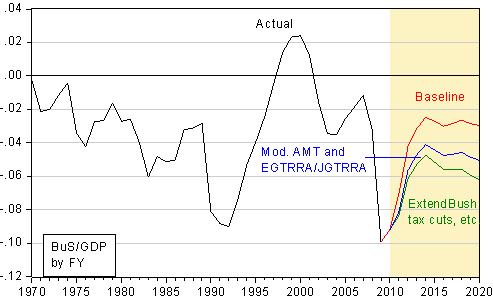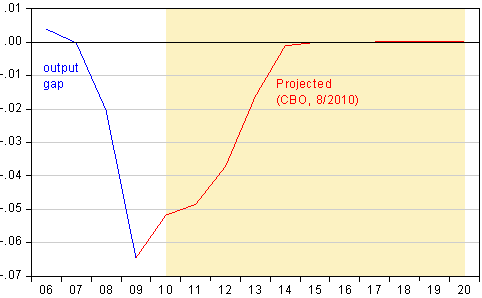...According to the CBO
In evaluating the advisability of extending either completely or partially the tax cuts of 2001 and 2003 (aka EGTRRA and JGTRRA), and implementing additional fixes to the AMT, one should consider the impact on the budget.
True fiscal hawks, for instance, should be interested in the gap between the CBO baseline (red) and the extending EGTRRA and JGTRRA and index the AMT for inflation (green line).

Figure 1: Deficit as a share of GDP, actual (black), under CBO baseline (red), under President's tax proposals for EGTRRA/JGTRRA and modification of AMT (blue) and extension of EGTRRA and JGTRRA and indexing AMT for inflation (green), by fiscal years. Shaded area is projected. Source: CBO, Budget and Economic Outlook: An Update (August 2010); CBO, An Analysis of the President's Budgetary Proposals for Fiscal Year 2011 (March 2010), CBO Historical Statistics, and author's calculations.According to the just released CBO, Budget and Economic Outlook: An Update [link], the impact on revenues of extending the EGTRRA/JGTRRA provisions is $2,652 billion, over the FY2011-2020 period; the increased debt service is estimated at $660 billion. If the EGTRRA/JGTRRA were extended, and the AMT indexed for inflation, then the impact on revenues would be $3,893 billion, with associated debt service of $947 billion.
According to the March 2010 CBO assessment of the President's budget [link], the impact on revenues from the partial extension of EGTRRA/JGTRRA is $2,154 billion over the FY2011-20 period, and from indexing the AMT $577 billion (Table 1-3). The CBO doesn't break out debt service associated with each of these measures, so I pro-rated the additional interest associated with the President's proposal (as scored by CBO). This implies a cumulative interest cost of around $485 billion.
The graph highlights the fact that these extensions hit particularly hard in the out years, when output has presumably come near potential; that is, in the out years, we would be running a structural budget deficit. This reinforces my view that it is foolhardy to focus on fiscal retrenchment now, when slack is at very high levels.

Figure 2: Output gap, expressed as a share of potential GDP. Shaded area is projected. Source: CBO, Budget and Economic Outlook: An Update (August 2010), and author's calculations.For an assessment of the differential impacts of full extension versus extension only for household dual incomes less than $250K (as in the President's proposal) versus allowing expiration of EGTRRA and JGTRRA as they were originally legislated, see this post.
“Passion and prejudice govern the world; only under the name of reason” --John Wesley
Thursday, September 9, 2010
The Budgetary Impact of EGTRRA/JGTRRA Extension and AMT Fixes
Subscribe to:
Post Comments (Atom)
No comments:
Post a Comment